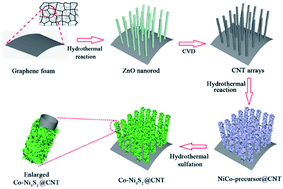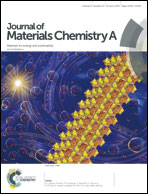Co-doped Ni3S2@CNT arrays anchored on graphite foam with a hierarchical conductive network for high-performance supercapacitors and hydrogen evolution electrodes†
Abstract
Engineering the surface structure and constructing a suitable internal conductive network is essential for the electron transfer rate and the active material utilization efficiency of an electrode. Here, high-porosity carbon nanotube (CNT) arrays grown on graphite foam (GNF) are synthesized via the self-sacrificial ZnO nanorod template. Then three-dimensional Co-doped Ni3S2 nanostructures (Co–Ni3S2) are coated on the CNT surface via a simple hydrothermal process. The CNTs/GNF hybrid with a hierarchical conductive network exhibits good electrical conductivity, while the tectorum-like Co–Ni3S2 nanosheet structure may facilitate both the ion and electron transfer in the redox process. Therefore, the Co–Ni3S2@CNTs/GNF composite shows a highest specific capacitance of 4.1 F cm−2, good rate performance (57.8% capacitance retention from 1 to 40 mA cm−2) and cycling stability (89.8% capacitance retention after 1000 cycles). Moreover, the Co–Ni3S2@CNT/GNF electrode also reveals good hydrogen evolution reaction activity in alkaline solution (an overpotential of 155 mV at 10 mA cm−2).



 Please wait while we load your content...
Please wait while we load your content...